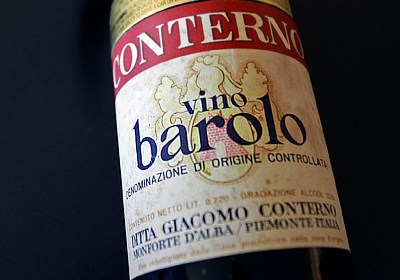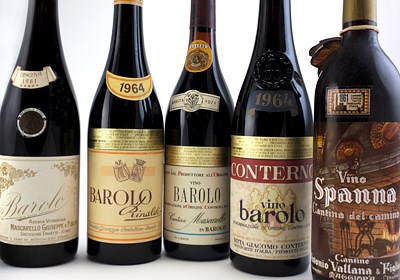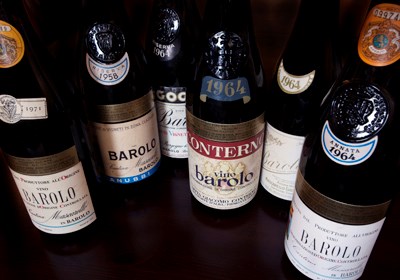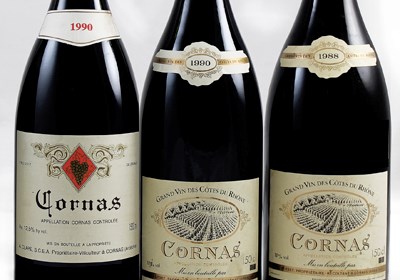
Which site would you like to visit?
By clicking the retail or wholesale site button and/or using rarewineco.com you are choosing to accept our use of cookies to provide you the best possible web experience.
Monday, June 21st, 2010 at Perbacco Ristorante, San Francisco, California
Born to Barolo's greatest winemaking family, Aldo Conterno is the son of Giacomo Conterno and the brother of Giovanni Conterno. And like his brother, he was groomed to continue his father's classic way of making wine.
While many have forgotten Aldo's contributions to Barolo's old school in the 1970s and 1980s, for at least two decades his wines were the essence of Old Style Barolo. But his style changed gradually in the 1990s, and the transformation accelerated as his sons became more involved in the family winery. Today, the Barolos made by Aldo and his sons Giacomo and Franco offer a different profile-one that straddles the line between traditional and modern.
Last Wednesday night, at San Francisco's Perbacco restaurant, The Rare Wine Co. hosted a remarkable retrospective of Aldo Conterno Barolos spanning 62 years. The wines were broken up into four flights: Cicala 1982-1999; Bussia Soprana 1978-1989; a look at the famous 1971 vintage, and then, finally, three very rare “pre-separation” wines, from the period before Aldo left the Giacomo Conterno winery to establish his own cantina.
If anyone had any doubts that Aldo was and is a fine winemaker, this tasting should have eliminated them, with virtually every wine showing a high level of instinct and craftsmanship, with the purity and nuance that are the essence of Barolo.
In the tasting, there were two 1982s, Bussia Soprana and Cicala, and both were tight and backward—as perfectly cellared bottles of great '82s should be—and still a good five to eight years away from their peak. The 1978 Bussia Soprana was a superb representative of this monumental year. But unlike '78s that still need to resolve their tannins, this bottle was perfection, with its opulent fruit overwhelming its structure.
The two 1971s—the rare Granbussia cuvée made entirely from Cicala fruit and the Barolo Riserva Speciale—were both typical of this famous vintage. They no longer possess the great power that the best 1978s show today, but there is plenty to remind us of the year's stature.
And even the 1999 Cicala, made at a time when Aldo's winemaking had changed significantly, seemed remarkably classic, mirroring the restraint of this structured year.
If there was one surprise for me among the post-1970 wines, it was the 1985 Barolo Cicala. Normally I favor the depth and classicism of the 1982s, finding 1985s to be delicious but sometimes a bit too soft to be truly great. But this bottle was an exhilarating exception: its concentrated richness and stunning texture providing a benchmark for what 1985s can be.
However, the part of the tasting that I most looked forward to was the chance to try some of the Barolos bearing Aldo's name that came from vintages before 1969. That was the year when brothers Giovanni and Aldo Conterno parted ways, with Giovanni taking over the Giacomo Conterno winery and brand and Aldo establishing his own cantina, also in Monforte d'Alba.
On the surface, it seems strange that there would be bottles of Barolo bearing the “Aldo Conterno” label before that year; and it seems all the more impossible that there would be such vintages as 1931 and 1937, since he was born in 1931. The explanation has always been that these were wines made by Giacomo Conterno and that Aldo was given them when he and Giovanni divided the assets of their father's winery.
Antonio Galloni confirmed this story in a conversation with Aldo Conterno a couple of years ago. Yet, one aspect of the mystery remained for me: the bottles themselves, which are all quite different from the bottles containing old Giacomo Conterno Barolos from the same vintages. Regardless of age, the old Aldo Conterno wines are in the same distinctive brown bottle that is Burgundy-shaped but with a notably longer neck and more sloping shoulders, and without the embossed Giacomo Conterno crest on the shoulder. How is it that they could be the same wines as the Giacomo Conterno Barolos?
A possible answer to that question can be found in the 1991 edition of Sheldon Wasserman's Italy's Noble Red Wines, where Wasserman wrote glowingly of tasting a 1931 Barolo with Aldo Conterno in 1985 that he said was bottled 16 years earlier from a 12.5-liter quarto di brenta. This of course would have been in 1969, the year of the separation, and this confirms that at least some of the wines given to Aldo were not yet in normal bottles in 1969-but were being stored in larger quarter brente for a slower evolution.
Another clue can be found on the neck label of some bottles of 1937 Aldo Conterno Barolo Riserva Speciale: “Questo vino di riserva speciale è stato travasato nel settembre 1969 per garantire la perfetta conservazione.” This translates as “This riserva speciale wine was transferred in September 1969 to ensure perfect preservation.” The perfect preservation that the label refers to is clearly the previous aging in massive quarter brente, so that when bottled in September 1969, the wine would have been far more youthful than a 1937 Barolo bottled in the early 1940s.
The Test
Our tasting included three pre-separation Aldo Conterno Barolos, all Riserva Speciales: 1967, 1964 and 1937. The first two wines closely mirrored the same vintages of 1964 and 1967 Giacomo Conterno Barolos we've tasted (no surprise since they would have been bottled at about the same time). The 1964 was delicate, as have been most bottles of 1964 Giacomo Conterno in our experience. But while the 1964 was a feminine example of that vintage, the 1967 was powerful—among the finest 1967s we've tasted, comparing well with the outstanding 1967 Giacomo Conterno Barolo. I would love to taste the two bottlings side by side.
Of course, we were most anxious to try the 1937 Riserva Speciale. I have had 1937 Giacomo Conterno Riserva Speciale several times in recent years and, apart from a brilliant bottle drunk with Roberto Conterno two years ago, most of the bottles have been somewhat faded (as you might expect from a '37 Barolo), still with charm, but without the depth of color or flavor of a younger Barolo. How would Aldo's bottling stack up?
It was, in fact, a shocker—deeper in color than the 1964, and rivaling the 1967 for youthful appearance. It still had plenty of fruit, and some tannin, and it tasted like a Barolo several decades younger. One taster was sure that the wine had been reconditioned—a logical suspicion under normal circumstances. But in fact, when we opened the bottle earlier that afternoon, it was still sealed with the original cork from 1969 and the opening was still covered by the original thin black foil that all the old Aldo Conterno bottles have. It was the original 1937 Barolo as bottled, probably from a 12.5-liter quarto di brenta, in 1969.
But why would this make the wine so youthful? The answer is that it received nearly a free ride for about three decades of its life, not only never leaving the village of Monforte d'Alba, but dwelling in a bottle more than 17 times the volume of a normal bottle. In other words, though it was vintaged in the 1930s, its exposure to oxygen during its life has been more like a Barolo from the 1960s.
In fact, for years, Aldo Conterno is known to have become engrossed with the idea that he could slow down the aging of his Barolos. As the photo below shows, he continued his father's practice of setting aside quarter brente of his Barolos, bottling 39 of these supertankers from the 1971 vintage. And in 1990, in Barolo: Tar and Roses, Michael Garner and Paul Merritt wrote of Aldo showing them “a 1974 Bussia Soprana that had been aged for about seven years in 12.5 litre bottles (a quarter brenta), stored under sand to minimize temperature fluctuation and rebottled in 75cl size in 1984. The colour was surprisingly dark, the bouquet still floral and fresh with hints of aniseed, and the palate rich, spicy and well knit. The only sign of the wine's true age was the way the tannin gave such an understated contribution on the finish.”
Apparently, Aldo was so happy with the condition of the wines bottled from brenta in 1969, he continued the practice on his own, setting aside 39 brente of 1971 Barolo.
We can't wait to try other examples of very old Barolos bottled by Aldo Conterno. Was the incredible youthfulness of our 1937 a fluke? And was the 1931 that Wasserman said in 1985 “showed no signs of fading” an aberration? Or will other very old Aldo Conterno Barolos be just as age-defying?
It seems likely that at least some will be—provided they've been very well-cellared since bottling in 1969. A perfect bottle could be among the wine treasures of Piemonte—especially from an early vintage like 1931, 1937, 1945 or 1952.
These older bottles are well worth searching for, though don't expect to find them easily. Rare even in 1969, how many could have survived until today?




New discoveries, rare bottles of extraordinary provenance, limited time offers delivered to your inbox weekly. Be the first to know.
Please Wait
Adding to Cart.
...Loading...


By clicking the retail or wholesale site button and/or using rarewineco.com you are choosing to accept our use of cookies to provide you the best possible web experience.

